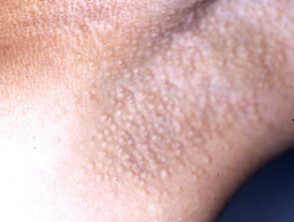What is Fox-Fordyce disease?
Fox-Fordyce disease is a rare skin disorder that occurs mainly in women between the ages of 13 and 35 years. However, it sometimes affects men and boys. The condition is also known as' apocrine duct occlusion"And" sweat retention disease ".
The condition is characterized by the development of itchy bumps around the hair follicles from the armpit area, the pubic region and around the nipples. Results from inflammation of the apocrine sweat glands, found only in these areas.
What are the signs and symptoms of Fox-Fordyce disease?
Fox-Fordyce disease can cause very intense itching that disturbs sleep, but in some cases it does not produce any symptoms. The condition occurs frequently in hot conditions, humidity, friction and stress. Common features include:
- Dome-shaped flesh-colored to small reddish papules affecting almost all hair follicle In the area
- Dark, thickened, and dry skin from scratching (lichenification)
- Reduced or absent sweating in the affected area.
The condition can persist for many years. In some cases, it can disappear in pregnancy for unknown reasons. In others, it may resolve into menopause (but it may persist afterward as well).
Fox-Fordyce disease

Fox-Fordyce disease

Fox-Fordyce disease

Fox-Fordyce disease

Fox-Fordyce disease
What causes Fox-Fordyce disease?
The cause of Fox-Fordyce disease is unknown. For some reason, apocrine sweat gets trapped like a scaly plug forms in the hair follicle. Apocrine sweat ducts break, leak, and become inflamed, resulting in severe itching.
Factors identified as part of the development of the condition include:
- Emotional and hormonal influences
- Alterations in the components of sweat.
How was the diagnosis made?
The diagnosis is made on the patient's history and the clinical appearance of the eruption.
What is the treatment for Fox-Fordyce disease?
There is no cure for Fox-Fordyce disease. Medical treatments that have been used with varying degrees of success include:
- Current retinoids
- Topical steroids
- Oral antibiotics
-
Clindamycin solution
- Antiandrogen hormone therapy
Other forms of treatment used are Ultraviolet radiation (phototherapy), dermabrasion, liposuction, and surgery excision.
